
The body of the 8cm Sightseeing Telescope
This particular model was first installed on the roof of a department store in Kamaishi. It was later used by a high school astronomy club to study the stars.
Kazuo Kimura Collection
Photo courtesy of Kimtec Co.
Nikon (formerly Nippon Kogaku K.K.) released many new products during the economic boom of the 1950s. One such product was a sightseeing telescope for installation at scenic spots and on the observation decks of towers and other tall buildings.
Monocular sightseeing telescopes
Nikon's first 8cm sightseeing telescope was mounted on the roof of the old terminal building at Haneda Airport in 1955. A caption in the catalog for the telescope revealed the company's pride in the product, as follows: "This product is a cultural facility that is fit to grace any tourist attraction in Japan, to the satisfaction of every visitor." Its features were:
- A high degree of magnification at 15x, a wide field of view, and clear observed images
- Waterproofing to allow outdoor installation
- Sealed-in dry air to prevent fogging of lenses
- Electronic timer used in payment collection mechanism
- Display of operating status using red and green lamps
- Circular direction-finder mount to allow appreciation of surrounding landscape
The green lamp lights up when the power is on. When the user inserts a coin, the shutter in the eyepiece opens electronically (enabling the telescope to be used for observation) and the red lamp lights up. The timer runs, and when one minute has elapsed, the green lamp also lights up. When two minutes have elapsed, the shutter closes and the red lamp goes off, so that once again only the green lamp is on.
A monocular configuration was adopted since binoculars would require the user to spend time adjusting the pupil distance, a troublesome task given the short space of time allowed for observation.
A 12cm 20x magnification telescope was then installed on the observation deck of Tokyo Tower, which was completed in December 1958. Neither the original telescope from Haneda Airport nor the one from Tokyo Tower exists today.

8cm Sightseeing Telescope
Objective diameter: 80 mm
Magnification: 15x
Angular field of view: 4°
Coin for operation: 10 yen
Observation time: 2 minutes
Total length of body tube: 500 mm
Height: 1.3 m (from ground to eyepiece)
Power supply: 100 V AC

12cm Sightseeing Telescope
Objective diameter: 120 mm
Magnification: 20x
Angular field of view: 3°
Coin for operation: 10 yen
Observation time: 1 minute 30 seconds
Total length of body tube: 750 mm
Height: 1.3 m (from ground to eyepiece)
Power supply: 100 V AC
Photo courtesy of Tokyo Tower
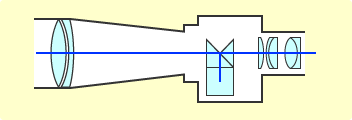
Optics of the 8cm Sightseeing Telescope
Spring-system telescope requiring no power supply
Since the 8cm and 12cm telescopes required power supplied from a wall socket, there were limitations on the types of location in which they could be installed. However, in 1961, Nikon launched a spring-system telescope that used a mechanical timer.
On this type of telescope the user would put in a coin and push down the lever. This caused the shutter in the eyepiece to open and the clockwork spring motor to rotate. The motor would drive the timer, which enabled observation for one minute and 30 seconds.
On some models built by other companies the lever was attached to the body. This sometimes caused the body to tilt when the lever was operated. As a result, Nikon located the lever on the stand so as to prevent unnecessary movement of the body. With a rotation angle of 360°, a depression angle of 35°, and an elevation angle of 40°, the Nikon telescope surpassed all its competitors in terms of operational range. The revamped optical system boosted magnification to 20x with the same 8cm effective diameter of the objective lens.
Waterproof and with no need of a power supply, the model proved popular, and by the mid-1960s it had been installed in over 1500 locations around Japan. With sales of the particular model lasting until the 1980s, the charge for use grew from one 10-yen coin to two 10-yen coins and then to one 50-yen coin.

Spring-system Sightseeing Telescope
Objective diameter: 80 mm
Magnification: 20x
Angular field of view: 2.5°
Coin for operation: 10 yen (at time of launch)
Observation time: 1 minute 30 seconds
Total length of body tube: 682 mm
Height: 1.3 m (from ground to eyepiece)
Photo courtesy of Iwaki City Town Hall
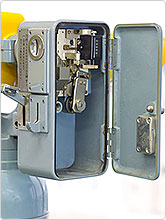
The cash box houses a coin sorting device, a timer and a counter.
Free sightseeing binoculars

5cm Sightseeing Binoculars
Objective diameter: 50 mm
Magnification: 15x
Angular field of view: 3.3°
Total length (body): 460 mm
Width (body): 250 mm
Height (body): 260 mm
Photo courtesy of Hodogaya Country Club
During the 1950s there was a domestic tourism boom in Japan, and people began to indulge in a wider range of leisure activities. Accommodation and leisure facilities of the day wanted to offer their customers an opportunity to enjoy the surrounding view. To meet this demand, Nikon began development of its 5cm Sightseeing Binoculars in 1959. With no timer or payment collection mechanism, the binoculars were installed in accommodation and leisure facilities to allow users to survey the view in their own good time. The binoculars came in two types: one pair with a large tripod attached, the other with an immovable stand.
Periscope-type sightseeing binoculars

20x80 Sightseeing Binoculars
Objective diameter: 80 mm
Magnification: 20x
Angular field of view: 3.3°
Coins for operation: 10 yen x2 (at time of launch)
Observation time: 1 minute 30 seconds
Total length: 265 mm
Height: 1.3 m (from ground to eyepiece)
Power supply: 100 V AC
Photograph courtesy of Kobe Port Tower
*It now costs 100 yen per use.
By the 1960s, there were at least 10 types of domestically manufactured telescope, and Nikon too began to consider producing new models. In March 1969, the designer of this product conducted an analysis of the usage patterns for telescopes on the observation decks at Tokyo Tower and Kasumigaseki Building, a typical high-rise building at the time.
Based on the results of this analysis, Nikon developed the 20x80 Sightseeing Binoculars, which were released in 1972. The principal features were as follows:
- Periscope-type optical system: one advantage of this system was that the objective lens could be moved up above the eyepiece lens. This also allowed for a shorter overall telescope, saving space. The telescope's unique vertical shape also appeals to users.
- Binocular configuration: this was developed by Nikon in response to numerous requests from owners.
- Viewfinder: the telescope was equipped with a viewfinder in the central part of the body. This feature was subsequently discontinued and was absent from models manufactured in 1979 and later.
- Ease of operation: with no need to adjust the focus or the pupil distance, the user could simply insert a coin and start using the telescope. To facilitate use by children, the pupil distance was set at 62 mm—slightly less than the human average of 64 mm. The telescope's point of focus was fixed at over 150 meters.
The new design made it easier for the observer to hold the eyepiece and tilt it upwards.
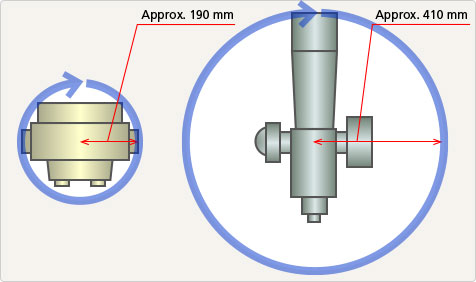
Comparison of the radius of rotation for the 20x80 Sightseeing Binoculars and the spring-system Sightseeing Telescope
The 20x80 Sightseeing Binoculars have a smaller radius of rotation thanks to the periscope configuration.
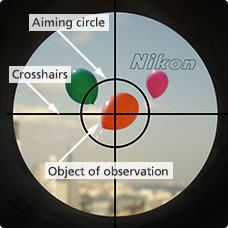
The 20x80 Sightseeing Binoculars viewfinder
The narrow field of view at the high magnification of x20 makes it difficult to quickly locate desired objects of observation. The 20x80 Sightseeing Binoculars overcame this problem with a viewfinder in the center of the body that had the aiming circle. The desired object of observation would be captured by aligning the object in the crosshairs with the aiming circle.
A modern-day telescope that achieves 30x magnification
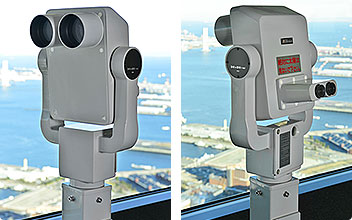
30x80 II Sightseeing Binoculars
Objective diameter: 80 mm
Magnification: 30x
Angular field of view: 2.7°
Coin for operation: 100 yen
Observation time: 1 minute 30 seconds (adjustable)
Total length: 345 mm
Height: 1.3 m (from ground to eyepiece)
Power supply: 3V lithium battery
Photo courtesy of Yokohama Landmark Tower
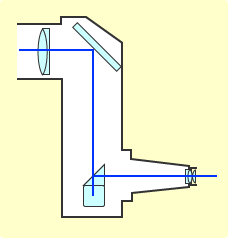
Optics for the 30x80 II Sightseeing Binoculars
In 1983, Nikon released the successor to the 20x Telescope in the shape of the 30x80 Sightseeing Binoculars, which inherited their predecessor's periscope-type optical system. Although designed for indoor use, the binoculars used a lithium battery as a power source and therefore did not need to be connected to a wall socket and so could be installed in a wider range of locations. Lithium batteries have a long life, lasting for approximately two years.
In 1985, Nikon released the waterproof 30x80 II Sightseeing Binoculars, which had sealed-in nitrogen to prevent fogging of the lenses. As they can be used outdoors, they have been installed in numerous scenic spots and are still being sold to this day. The adoption of the coin recognition mechanism used in automatic vending machines enables this model to accept other currencies as well.
Nikon sightseeing telescopes have continued to evolve over the course of more than 50 years of sales. Today, they offer the user clear, striking views and can be found all over the world. We hope that everyone who encounters Nikon telescopes will derive great pleasure from their visual power and clarity.

